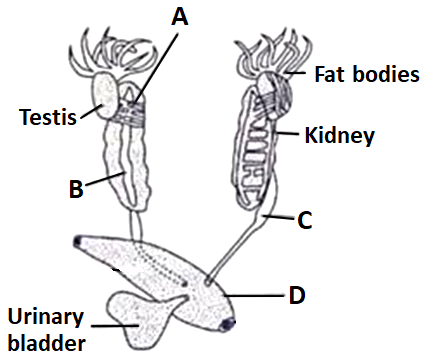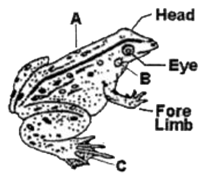Select Question Set:
In frog, all are cellular aggregations around nerve endings except-
1. Sensory papillae
2. Taste buds
3. Nasal epithelium
4. Eyes and internal ear
Subtopic: Frogs: Anatomy (Nervous System) |
83%
From NCERT
Please attempt this question first.
Hints
Please attempt this question first.
Which of the following sequences is correct for the passage of sperms in frog (male)-
1. Testis → Bidder's canal → Vasa efferentia → Urinogenital duct → cloaca → cloacal aperture
2. Testis → Vasa efferentia → Bidder's canal → Urinogenital duct → cloaca → cloacal aperature
3. Testis → Urinogenital duct → Bidder's canal → Vasa efferentia → cloaca → cloacal aperture
4. Testis → Vasa efferentia → Urinogenital duct→ Bidder's canal → cloaca → cloacal aperature
1. Testis → Bidder's canal → Vasa efferentia → Urinogenital duct → cloaca → cloacal aperture
2. Testis → Vasa efferentia → Bidder's canal → Urinogenital duct → cloaca → cloacal aperature
3. Testis → Urinogenital duct → Bidder's canal → Vasa efferentia → cloaca → cloacal aperture
4. Testis → Vasa efferentia → Urinogenital duct→ Bidder's canal → cloaca → cloacal aperature
Subtopic: Frogs: Anatomy (Male Reproductive System) |
82%
From NCERT
Please attempt this question first.
Hints
Please attempt this question first.
In male frog, cloaca is used to pass out -
1. Faecal matter only
2. Urine only
3. Sperms only
4. Faeces, urine and sperm
1. Faecal matter only
2. Urine only
3. Sperms only
4. Faeces, urine and sperm
Subtopic: Frogs: Anatomy (Digestive System) |
94%
From NCERT
Please attempt this question first.
Hints
Please attempt this question first.
Go through the following figure indicating the male reproductive system of frog. Identify A to D -


| A | B | C | D | |
| 1. | Bidder's canal | Adrenal gland | Urinogenital duct | Rectum |
| 2. | Bidder's canal | Adrenal gland | Urinogenital duct | Cloaca |
| 3. | Vasa efferentia | Adrenal gland | Urinogenital duct | Cloaca |
| 4. | Vasa efferentia | Thyroid gland | Urinogenital duct | Cloaca |
Subtopic: Frogs: Anatomy (Male Reproductive System) |
75%
From NCERT
Please attempt this question first.
Hints
Please attempt this question first.
For female frog, which of the following is false?
| I. | One pair ovaries is situated near kidneys |
| II. | Ovary has functional connection with kidney |
| III. | Convoluted, tubular, ciliated and glandular oviduct arises from ovary and opens into cloaca |
| IV. | Oviduct and ureter open separately into the cloaca |
| V. | A female frog can lay 2500-3000 ova at a time |
| 1. | I and II | 2. | only II |
| 3. | I and IV | 4. | IV and V |
Subtopic: Frogs: Anatomy (Female Reproductive System) |
68%
From NCERT
Please attempt this question first.
Hints
Please attempt this question first.
Which of the following is false?
1. Fertilization is external (in water) in frog
2. In frog, development involves larval stage called tadpole
3. Tadpole undergo metamorphosis to form the adult
4. Development in frog is direct
1. Fertilization is external (in water) in frog
2. In frog, development involves larval stage called tadpole
3. Tadpole undergo metamorphosis to form the adult
4. Development in frog is direct
Subtopic: Frogs: Anatomy (Female Reproductive System) |
94%
From NCERT
Please attempt this question first.
Hints
Please attempt this question first.
Identify A, B and C respectively -

1. Trunk, Tympanum, Web
2. Neck, Brown eye spot, Web
3. Trunk, Tympanum, Hind limb
4. Neck, Tympanum, Hindlimb

1. Trunk, Tympanum, Web
2. Neck, Brown eye spot, Web
3. Trunk, Tympanum, Hind limb
4. Neck, Tympanum, Hindlimb
Subtopic: Frogs: Morphology |
51%
From NCERT
Please attempt this question first.
Hints
Please attempt this question first.
The skin of frog:
1. Is smooth and slippery due to the presence of mucus
2. In the dorsal side is usually pale yellow
3. In the ventral side is usually olive green with dark irregular spots
4. Is related to all the above statements
1. Is smooth and slippery due to the presence of mucus
2. In the dorsal side is usually pale yellow
3. In the ventral side is usually olive green with dark irregular spots
4. Is related to all the above statements
Subtopic: Frogs: Morphology |
82%
From NCERT
Please attempt this question first.
Hints
Please attempt this question first.
Eyes of frogs:
1. Are bulged and lacks nictitating membrane
2. Posses nictitating membrane that protects them while in water
3. Provide them with 180° vision
4. Are compound eyes
1. Are bulged and lacks nictitating membrane
2. Posses nictitating membrane that protects them while in water
3. Provide them with 180° vision
4. Are compound eyes
Subtopic: Frogs: Morphology |
89%
From NCERT
Please attempt this question first.
Hints
Please attempt this question first.
Frogs:
1. Exhibit sexual dimorphism
2. Have hindlimbs and forelimbs which help in walking, leaping and burrowing
3. Have webbed digits that help in swimming
4. Show all of the above features
1. Exhibit sexual dimorphism
2. Have hindlimbs and forelimbs which help in walking, leaping and burrowing
3. Have webbed digits that help in swimming
4. Show all of the above features
Subtopic: Frogs: Morphology |
89%
From NCERT
Please attempt this question first.
Hints
Please attempt this question first.
Select Question Set:






